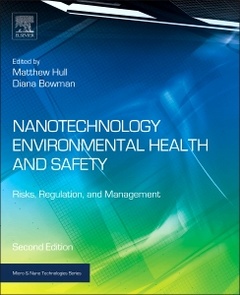Nanotechnology Environmental Health and Safety (2nd Ed.) Risks, Regulation, and Management Micro and Nano Technologies Series
Coordonnateurs : Hull Matthew, Bowman Diana

2. What are the warning signs we should be looking for?
3. Are we willing to heed the lessons of the past? Nanomaterials and Australia's asbestos legacy
4. Characterization of Nanomaterials for Nano EHS studies
5. Toxicological Studies with Nanoscale Materials - what we've learned so far
6. Nanomaterials ecotoxicology: a case study with nanosilvers
7. A Case Study of a Nanoscale-Research Facility Safety through Design and Operation
8. A Nanomaterial Registry
9. Two Steps Forward, One Step Back: Shaping the Nanotechnologies Landscape through Regulatory Choice
10. A Nanotechnology Legal Framework
11. Nanotechnology Risk Management: An Insurance Industry Perspective
12. Commercialization of Cellulose Nanocrystal (NCCTM) Production: A business case focusing on the importance of proactive EHS management
13. Nanomaterials and Health - Implications for Medicines, Energy, and Food
14. Nanoinformatics: data driven materials design for health and environmental needs
15. Nano EHS threats of the future
16. Nanotechnology: A Sustainable Industrial Revolution?
Researchers in academic and national laboratories, Regulators at the state and federal levels, Business professionals involved in development, manufacturing, and commercialization of emerging nanotechnologies, Risk managers and insurance professionals.
Diana M. Bowman is an Andrew Carnegie Fellow, an Associate Professor in the Sandra Day O’Connor College of Law, where she serves as the Associate Dean for International Engagement, and the School for the Future of Innovation in Society, where she serves as the Associate Director for Students, at Arizona State University. She is also a visiting international scholar in the Faculty of Law at KU Leuven. Bowman’s research has primarily focused on the legal and policy issues associated with emerging technologies and public health law. Bowman earned her BSc (Physiology), a LLB, and a PhD in Law from Monash University. In August 2011, she was admitted to practice as a Barrister and Solicitor of the Supreme Court of Victoria.
- Practical guidance on risk management and mitigation across different legislative frameworks worldwide
- Reviews toxicological studies and industrial initiatives, supported by numerous case studies
- Includes extensive new material on the implications of nanotechnology for medicine, energy and food, as well as assessing future threats
Date de parution : 10-2018
Ouvrage de 464 p.
19x23.3 cm
Ancienne édition
Accéder à la nouvelle édition.
Date de parution : 06-2014
Ouvrage de 464 p.
19x23.3 cm
Ancienne édition
Accéder à la nouvelle édition.
Thèmes de Nanotechnology Environmental Health and Safety :
Mots-clés :
ACTU; ANBF; Advanced materials; Advanced products; Asbestos; BCF/BAF; BET; Birck Nanotechnology Center; Black box; Carbon nanotubes; Cellulose nanocrystals; Civil law; Cleanroom; Co-regulation; Compliance level rating; Comprehensive environmental assessment; DEFRA; Data mining; Deepwater Horizon; EH&; S; EHS; EU; Ecotoxicology; Engineered nanomaterials; Environmental health and safety; European Environment Agency; GDP; Gulf oil disaster; ISO; Insurance; Intellectual property; MIANs; MWCNTs; Manufactured nanoparticles; MoA; Multi-criteria decision analysis; NCC™; NIOSH; NIST; NKI; NanoEHS; NanoExPERT; Nanoceria; Nanoinformatics; Nanomaterial; Nanomaterials; Nanoparticle Ontology; Nanotechnology; Nanotechnology risks; Nanotherapeutics; Nanotoxicology; OECD; OSHA; Personal protective equipment; Prevention through Design; QSAR; REBSPA; Reference materials; Risk management; Risk red flags; SAXS; SNUR; STEM; SWA; Science Citation Index; Self-insurance; Soft law; Sustainability; TEM; TLV-TWA; Trade unions; WHO; WPN



